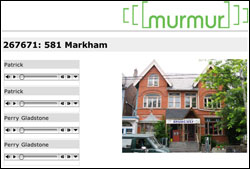By Nathan Alderman, J-Lab Online Editor
In three of Canada’s largest cities, an innovative volunteer project is gathering and recording oral histories of neighborhood landmarks to share via phones and the Internet.
 Murmur launched in 2003 and now offers more than 100 stories and reminiscences about people and places in Toronto’s Kensington Market and Annex neighborhoods, Vancouver’s Chinatown, and Montreal’s French-speaking St-Laurent Boulevard.
Murmur launched in 2003 and now offers more than 100 stories and reminiscences about people and places in Toronto’s Kensington Market and Annex neighborhoods, Vancouver’s Chinatown, and Montreal’s French-speaking St-Laurent Boulevard.
“People tend to undervalue their stories or insist that we wouldn’t be interested in ‘their kind’ of stories,” co-founder Gabe Sawney said. “Without exception, though, great stories start pouring out sooner or later.”
Murmur’s goal is to encourage people to use their cell phones and actually take walking tours of the neighborhoods as they listen to one- to three-minute pre-recorded stories. In the process, Murmur’s founders hope to forge a connection between physical locations and the memories that give them meaning.
Murmur was founded by Sawhney, Shawn Micallef and James Roussel, all students at Habitat, the Canadian Film Centre’s new media lab. “All of us were very interested in the city, history and stories,” Sawhney said. “We wanted to work on a project that would help commemorate these important but hidden and easily-forgotten histories.”
Murmur founders post green ear-shaped stickers on buildings and parks for which they’ve collected stories. To hear the stories free of charge, users dial the Murmur phone number and punch in a four- to six-digit code listed on the sticker.
Standing in front of a Toronto bar, you can hear one of its bartenders talk about the night a careless cigarette butt almost burned the place down. In Vancouver, a former dot-com employee explains how his old office building was once a hub for the city’s trains and trolleys. The stories—mostly in English but with some in French and Cantonese—can also be found, with photos of their subject, on Murmur’s three neighborhood-specific Web sites. To promote the service, Murmur prints up postcards with funky hand-drawn maps of each neighborhood, which are distributed by local businesses.
Sawhney, Micallef and Roussel chose cell phones as the main medium for their project to make their stories easily accessible to the public. “We wanted (Murmur) to be engaging,” Sawhney said, “to encourage people to get away from the (computer) screen and go physically experience these places as they listened to the stories.”
Murmur is a volunteer activity for its three founders: Sawhney is a web designer, Micaleff is a writer and Roussel writes and acts. Its expansions have been funded by local and national arts councils.
“The project isn’t expensive to run because we’ve got a great team,” Sawhney said. “The most time-consuming part is collecting the stories.”
When someone wants to add a story to Murmur, they call in or fill out a form on one of Murmur’s Web sites. Project volunteers then visit the new storyteller to record the story in person, often on location. The whole process generally takes a couple hours, although some sessions can last longer and yield multiple stories. Sawhney estimates the Murmur team adds about two or three stories a week. “This winter, we’ll be experimenting with allowing people to record stories using their phone,” Sawhney said.
After recording, the Murmur team edits each story using open-source Audacity software. They post stories to the Web site for the appropriate neighborhood and to a computer connected to the Murmur phone line. Using Interactive Voice Response (IVR) software, the computer can answer phone calls and respond to touch-tone instructions from callers. Though Murmur currently uses a commercial IVR system, Sawhney said they plan to switch to free, open-source Asterisk software in early 2005.
The stories callers can dial up on Murmur attempt to put a more human face on neighborhood lots and storefronts. The owner of a thrift store recounts the punk-rock band that lived upstairs from his shop in the business’ early days, while one of his customers wistfully recalls buying a dress there that made her feel like a goddess.
In Chinatown, where stories are available in both English and Cantonese, visitors dialing up Dr. Sun Yat-Sen Park can hear a tale of falling through the ice on the park’s pond in winter; a recollection of attending the park’s opening from a prominent Chinese-Canadian architect; and information about the area’s nightclubs from a local historian. Toronto’s Seaton Walk Park harbors insights from of one of its gardeners and a woman’s story of spotting a mysterious naked man casually strolling up the street and through the park.
On the Toronto site, the busiest, Murmur receives about 60 visitors each day. So far, Sawhney said, visits to the Web site outnumber calls to the phone system. “People aren’t used to using their mobile phones this way,” he said.
At present, each of Murmur’s four sites costs between $5,000 and $20,000 in Canadian dollars to run each year, depending on its stage of development. Though Murmur currently uses normal telephone lines, it will switch to Internet-based voice-over-IP technology in winter 2004 to cut costs and make new branches easier to launch.
Murmur’s founders plan to expand to more neighborhoods across Canada and perhaps to other countries as well. “We’ve had interest from community groups all across North America and Europe,” Sawhney said. He and his fellow creators are getting nothing but positive feedback from their current audience. “People seem to really enjoy the project,” he said.
“I love it when I hear that someone listened to a story about a shop/bar/building/whatever, which is gone now, and they’d forgotten about” Sawhney said, “but had a flood of memories rush back when they heard the story.”



